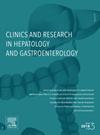Proton Pump Inhibitor Use and Risk of Hepatic Encephalopathy in Cirrhotic Patients: A Systematic Review and Meta-analysis
IF 2.4
4区 医学
Q2 GASTROENTEROLOGY & HEPATOLOGY
Clinics and research in hepatology and gastroenterology
Pub Date : 2025-08-12
DOI:10.1016/j.clinre.2025.102667
引用次数: 0
Abstract
Background
Hepatic encephalopathy (HE) is a debilitating complication of liver cirrhosis, characterized by neuropsychiatric symptoms ranging from mild cognitive impairment to coma. Proton pump inhibitors (PPIs) are widely used in cirrhotic patients for managing gastrointestinal conditions. However, emerging evidence has suggested a potential link between PPI use and HE, possibly due to increased intestinal permeability and bacterial translocation.
Objective
To evaluate and synthesize current evidence on the association between PPI use and the risk of hepatic encephalopathy in patients with liver cirrhosis through a systematic review and meta-analysis.
Methods
A total of 22 studies were included in this systematic review and meta-analysis, comprising both case-control and cohort designs. Hazard ratios (HRs) and odds ratios (ORs) were used to quantify the association between PPI use and the development of HE.
Results
The initial pooled analysis showed that PPI use was associated with an increased risk of HE, with a hazard ratio (HR) of 1.59 (95 % CI: 1.42–1.77) and an odds ratio (OR) of 2.07 (95 % CI: 1.57–2.72; I² = 96.4 %, p < 0.0001).
In the OR group, a subgroup analysis by study type showed:
Case-control studies: OR = 2.29 (95 % CI: 1.46–3.59, I² = 76.9 %, p < 0.0017).
Retrospective cohort studies: OR = 1.107 (95 % CI: 1.05–1.166, I² = 0 %, p = 0.97).
Nardelli et al. and Sun et al. were not pooled as they were prospective cohort studies.
In the HR group, all included studies were retrospective cohort studies, so no further subgroup analysis was performed.
After excluding high-risk studies/abstracts, the pooled HR was 1.49 (95 % CI: 1.266–1.743, I² = 37.9 %, p = 0.153).
Conclusion
This meta-analysis supports a potential association between PPI use and an increased risk of hepatic encephalopathy in cirrhotic patients. These findings underscore the importance of cautious and judicious use of PPIs in this vulnerable population, reserving them for clear clinical indications.
肝硬化患者使用质子泵抑制剂和肝性脑病的风险:一项系统回顾和荟萃分析。
背景:肝性脑病(HE)是肝硬化的一种衰弱性并发症,以神经精神症状为特征,从轻度认知障碍到昏迷。质子泵抑制剂(PPIs)广泛用于肝硬化患者的胃肠道疾病管理。然而,新出现的证据表明PPI的使用与HE之间存在潜在的联系,可能是由于肠道通透性和细菌易位的增加。目的:通过系统回顾和荟萃分析,评价和综合目前关于肝硬化患者使用PPI与肝性脑病风险相关性的证据。方法:本系统综述和荟萃分析共纳入22项研究,包括病例对照和队列设计。使用风险比(hr)和优势比(ORs)来量化PPI使用与HE发展之间的关系。结果:初始汇总分析显示,PPI使用与HE风险增加相关,风险比(HR)为1.59 (95% CI: 1.42-1.77),优势比(OR)为2.07 (95% CI: 1.57-2.72;I² = 96.4%,p < 0.0001)。在OR组中,按研究类型进行的亚组分析显示:病例对照研究:OR = 2.29 (95% CI: 1.46-3.59, I² = 76.9%,p < 0.0017)。回顾性队列研究:OR = 1.107 (95% CI: 1.05-1.166, I² = 0%,p = 0.97)。Nardelli等人和Sun等人没有纳入研究,因为他们是前瞻性队列研究。在HR组中,所有纳入的研究均为回顾性队列研究,因此未进行进一步的亚组分析。排除高危研究/摘要后,合并HR为1.49 (95% CI: 1.266-1.743, I² = 37.9%,p = 0.153)。结论:该荟萃分析支持PPI使用与肝硬化患者肝性脑病风险增加之间的潜在关联。这些发现强调了在这些易感人群中谨慎和明智地使用PPIs的重要性,保留它们用于明确的临床适应症。
本文章由计算机程序翻译,如有差异,请以英文原文为准。
求助全文
约1分钟内获得全文
求助全文
来源期刊

Clinics and research in hepatology and gastroenterology
GASTROENTEROLOGY & HEPATOLOGY-
CiteScore
4.30
自引率
3.70%
发文量
198
审稿时长
42 days
期刊介绍:
Clinics and Research in Hepatology and Gastroenterology publishes high-quality original research papers in the field of hepatology and gastroenterology. The editors put the accent on rapid communication of new research and clinical developments and so called "hot topic" issues. Following a clear Editorial line, besides original articles and case reports, each issue features editorials, commentaries and reviews. The journal encourages research and discussion between all those involved in the specialty on an international level. All articles are peer reviewed by international experts, the articles in press are online and indexed in the international databases (Current Contents, Pubmed, Scopus, Science Direct).
Clinics and Research in Hepatology and Gastroenterology is a subscription journal (with optional open access), which allows you to publish your research without any cost to you (unless you proactively chose the open access option). Your article will be available to all researchers around the globe whose institution has a subscription to the journal.
 求助内容:
求助内容: 应助结果提醒方式:
应助结果提醒方式:


